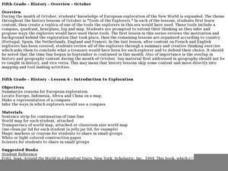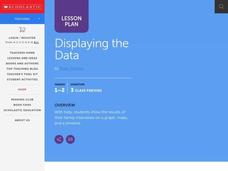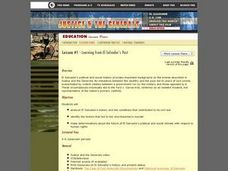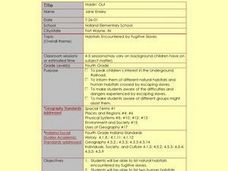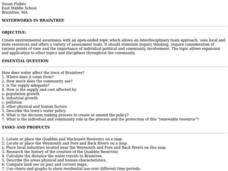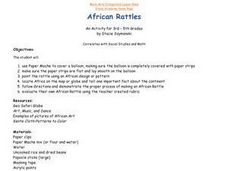Curated OER
Follow That Ship!
Students in this exercise are introduced to the distinct ways of measuring distance (nautical miles) and speed (knots) at sea, as well as the concepts of latitude and longitude for establishing location.
Curated OER
Medieval Castles
Second graders design a scale model of a medieval castle and its surroundings including the following items: castle, moat, bailey, drawbridge, turrets, dungeon, grounds, and outer walls. A perfect lesson for those kids who are fascinated...
Curated OER
Past v. Present: Using Geography & Anthropology
Students examine artifacts and documents from their Canadian community. They analyze early Canadian history and make predictions about the future of the country.
Curated OER
Tools of the Explorers
Fifth graders examine the history of the European exploration of the New World. They research and create replicas of many of the tools used by the explorers including a compass, quadrant, hourglass, log and map.
Curated OER
Geography and Ecology of the Inuit
Students examine environment and ecology of the Arctic region, and explore history and traditions of the Inuit.
Curated OER
Where In The World?
Learners identify the goods and services from the United States and Mexico. Using postage stamps, they describe the various images they see and place them into categories. They use those categories to determine what is important in...
Curated OER
Remember the Bridge: Poems of a People
Fifth graders explore poems of African Americans. They research a famous African American, write a report, create a timeline of events in African American history, create a map of the New World, and research Molly Walsh. After...
Curated OER
Displaying The Data
Students engage in a research project to find information about one's personal family heritage. They collect information by conducting family interviews. Students use the data to create a graph, map, and timeline. Then students take part...
Curated OER
Africans in Mexico
Students read case studies to examine the role of Africans in Mexico. Using maps, they research the areas that are discussed in the text and map out movement maps of Africans to and from Africa. They research the history of the Mexico...
Curated OER
The European Union
Ninth graders construct a timeline depicting the development of the European Union and label and color countries on a map belonging to it. They write essays about how the Union affects the United States.
Curated OER
Japanese Manners and Life Style
Students continue their examination of modern Japan and its culture. Using a map, they locate various cities and landforms in the country and watch a video on related topics in which the make a timeline of key events. In groups, they...
Curated OER
Connections Between World Events, Geography and the Human Quest for Knowledge
Students examine the relationship between innovations in geography and world events. Using maps, they report different information from a spatial perspective. They develop hypothesis about how man's quest for knowledge has impacted the...
Curated OER
What is a Folktale?
Young scholars are read an apache folktale and discuss the characters in the story. Using the text, they identify the factors that make it a folktale and not a fairy tale. On a map, they locate where the Apache people live. As a class,...
Curated OER
Learning From El Salvador's Past
Students analyze El Salvador's history and the conditions that contributed to its civil war. identify the factors that led to the churchwomen's murder. Make determinations about the future of El Salvador's political and social climate...
Curated OER
Geography: Islands and Alcatraz
Learners, in groups, create maps of islands including map keys and compass roses. They compare and contrast their island communities with that of the island prison, Alcatraz. Students select from a series of projects, including writing...
Curated OER
Glad to Meet You, Newfane
Students brainstorm a list of important community locations or buildings. We take pictures of inside and outside and include the history of each. They describe the service or product it provides, the date originated, etc. They build a...
Curated OER
Geology and it’s Influence
Students compare current geological map and the one from 1800's. In this earth science lesson, students discuss differences between the two and explain the factors that caused the change. They write an essay about how these changes...
Curated OER
Hidin' Out
Fourth graders draw three major Underground Railroad routes crossing Indiana on an outline map and include habitats and towns. They produce an oral history involving at least three natural habitats and one human habitat.
Curated OER
Waterworks In Braintree
Students examine how water affects the community of Braintree. Using a map, they locate main resevoirs and rivers in the area and research the history of one of the resevoirs. They use charts and graphs to show how land use has changed...
Curated OER
Passport to the Eastern Hemisphere
Seventh graders create a time line of significant dates in the history of their nation. This requires students to examine the entire history of a country and make informed judgments based on their historical knowledge.
Curated OER
African Rattles
Students locate Africa on the map or globe and tell one important fact about the continent. They follow directions and demonstrate the proper process of making an African Rattle.
Curated OER
Find the Oldest
Students track down their town's oldest standing man-made landmark. By learning more about the oldest structure in their area (whether it's a church, store, graveyard, bridge, etc.), they discover interesting details about their town's...
Curated OER
Local Area - What Is a Region?
Young scholars examine the physical characteristics of the Connecticut River Valley. They view and analyze maps, identify common physical characteristics, and color in the Connecticut River on a map of New Hampshire and Vermont.
Curated OER
Local Area - What Is a Region?
Students examine the physical characteristics of the Connecticut River Valley. They analyze maps and pictures, identify physical characteristics of the region, and color in the Connecticut River on a map.



